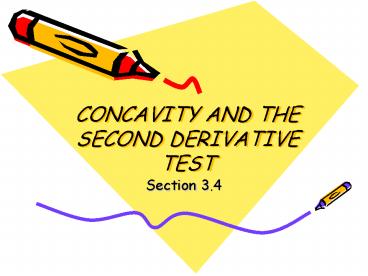CONCAVITY AND THE SECOND DERIVATIVE TEST - PowerPoint PPT Presentation
1 / 13
Title:
CONCAVITY AND THE SECOND DERIVATIVE TEST
Description:
Locate the critical numbers of Use these numbers to determine the test intervals. Determine the sign of at one test value in each of the intervals. ... – PowerPoint PPT presentation
Number of Views:424
Avg rating:3.0/5.0
Title: CONCAVITY AND THE SECOND DERIVATIVE TEST
1
CONCAVITY AND THE SECOND DERIVATIVE TEST
- Section 3.4
2
When you are done with your homework, you should
be able to
- Determine intervals on which a function is
concave upward or concave downward - Find any points of inflection of the graph of a
function - Apply the Second Derivative Test to find relative
extrema of a function
3
I lived from 1642-1715. I developed Calculus. I
called Calculus Fluents and Fluxions. I
discovered the law of gravity. I generalized the
Binomial Theorem. Who am I?
- Fermat
- Newton
- Pythagoras
- Pascal
4
Definition of Concavity
- Let f be differentiable on an open interval I.
The graph of f is concave upward on I if
is increasing on the interval and concave
downward on I if is decreasing on the
interval. - concave down concave up
5
Theorem Test for Concavity
- Let f be a function second derivative exists on
an open interval I. - If for all x in I, then f is
concave upward in I. - If for all x in I, then f is
concave downward in I.
6
Definition Point of Inflection
- Let f be a function that is continuous on an open
interval and let be a point in the
interval. If the graph of I has a tangent line
at this point , then this point is a
point of inflection of the graph of f if the
concavity of f changes from upward to downward
(or downward to upward) at the point .
7
Theorem Point of Inflection
- If is a point of inflection of the
graph of f, then either or
does not exist at - Hmmm.so this means that c is a ________
- __________ of the ___________.
8
Guidelines for Determining Concavity on an
Interval I and Finding Points of Inflection
- Locate the critical numbers of Use
these numbers to determine the test intervals. - Determine the sign of at one test value
in each of the intervals. - Use the theorem regarding the test for concavity
to determine whether is concave upward
or concave downward on each interval. - Examine the results of the test for a change in
concavity to determine if there are any
inflection points.
9
Find the points of inflection and discuss the
concavity of the graph of the function
- The function is concave upwards over its entire
domain. There is a point of inflection at (0 ,
3) - The function is concave upwards on and
concave downwards on - The function is concave upwards over its entire
domain and there are no points of inflection. - None of the above
10
The most famous algebraist of the 1600s was
Fermat. Along with Pascal, he founded the
subject of
- Probability
- Number Theory
- Abstract Algebra
- All of the above.
11
5 cards are selected without replacement from a
standard 52 card deck. Find the probability that
all the cards are spades. This is called a
straight flush in poker.
- Both B and D
12
Theorem Second Derivative Test
- Let f be a function such that and
the second derivative of f exists on an open
interval containing c. - If then f has a relative minimum
at - If then f has a relative maximum
at - If the test fails. That is, f may
have a relative maximum, a relative minimum, or
neither. In such cases, you can use the First
Derivative Test.
13
The following function has a relative minimum at
- 6856.0
- 0.0































